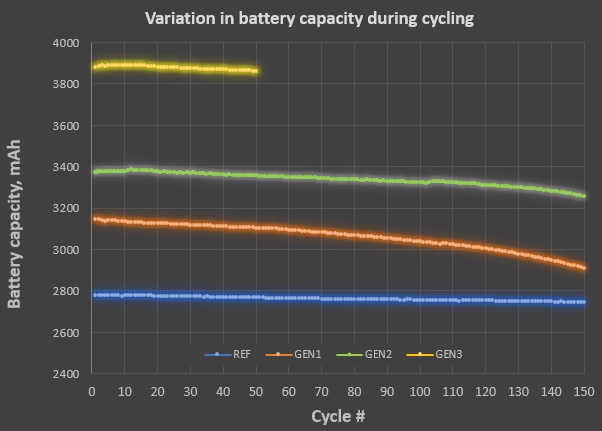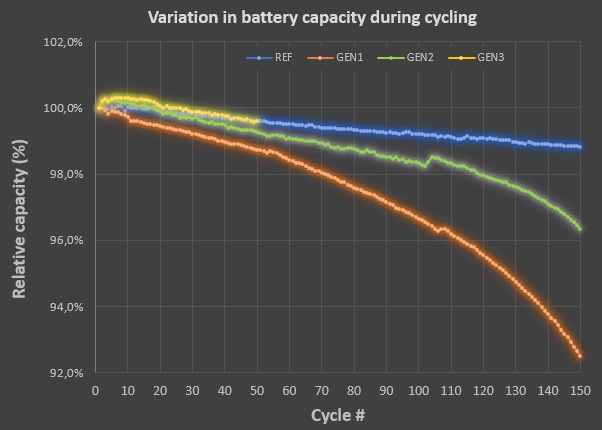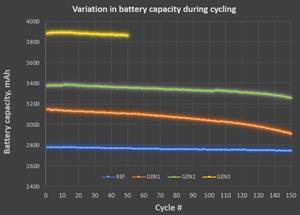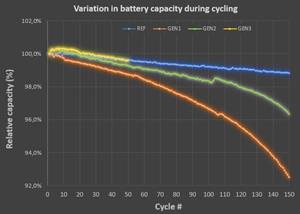GEN3 Silicon-Anode Lithium-Ion Batteries Outperform Graphite by 40% Without Degradation After 50 Cycles
- After 50 cycles, 18650 batteries with GEN3 silicon-based material show a 40% capacity improvement over graphite, 25% over GEN1, and 15% over GEN2, with no noticeable degradation [1].
MONTREAL, Aug. 21, 2024 (GLOBE NEWSWIRE) -- HPQ Silicon Inc. (“HPQ” or the “Company”) (TSX-V: HPQ, OTCQB: HPQFF, FRA: O08), a technology company specializing in green engineering of silica and silicon-based materials is pleased to announce the latest significant battery milestones achieved by its France-based affiliate, NOVACIUM SAS ("Novacium").
This announcement covers the results of 50 charge-discharge cycle tests conducted to simulate real-world usage and assess the durability and longevity of the latest batch of Lithium-ion 18650 commercial batteries, made with a blend of graphite and Novacium’s partially optimized GEN3 advanced silicon-based anode material. The 18650 GEN3-based batteries performed remarkably well, with an overall capacity improvement of about 40% compared to a graphite benchmark.
It should be noted here that this performance is 25% higher than that of the previous GEN1 material and 15% higher than that of the GEN2 material, with performance degradation so minimal compared to the graphite benchmark that it falls within the margin of error.
“Producing 18650 battery cells that excel in charge-discharge cycle testing and exceed 4,000 mAh under maximum discharge conditions (July 30th, 2024, release) further confirms our position as a top-tier producer of advanced silicon anode material,” said Dr. Jed Kraiem, COO of Novacium. “Based on these results and the data we’ve gathered, we are confident that we can continue improving our material, and that GEN4-based 18650 batteries could exceed the 4,400 mAh mark."
Enhancing Battery Performance with Silicon-Based Anode Materials

Graph 1) the blue line shows the average capacity of 100% graphite batteries, the orange line, the average capacity of GEN1 batteries, and the green line the average capacity of GEN 2 batteries, over 150 charge-discharge cycle testing [1] while the yellow line shows the average capacity of GEN3 batteries over 50 charge-discharge cycle testing [1]. All readings are in milliampere-hours (mAh).
Graph 1 shows batteries made with Novacium GEN3 materials registered significantly higher capacities over the first 50 cycles than those made with GEN2 and GEN1 materials, as well as the 100% graphite benchmarked batteries.
The average capacity of three 18650 batteries made with Novacium GEN3 materials (yellow line) started at 3,883.0 mAh and decreased to 3,864.8 mAh by the 50th cycle. In comparison, batteries made with Novacium GEN2 materials (green line) started at 3,370.1 mAh and decreased to 3,356.0 mAh, while those with GEN1 materials (orange line) started at 3,145.5 mAh and dropped to 3,105.4 mAh. Finally, the average capacity of three 18650 batteries made with 100% graphite (blue line) started at 2,780.0 mAh and decreased to 2,769.1 mAh by the 50th cycle.
Therefore, after 50 cycles, GEN3 silicon-based batteries show an overall capacity improvement of approximately 40% compared to the graphite benchmark, 25% compared to GEN1 material, and 15% compared to GEN2 material.
Silicon-Based Anode Materials delivering graphite-like battery degradation results at 50 cycles

Graph 2) the blue line shows the relative capacity of 100% graphite batteries, the orange line the relative capacity of GEN1 batteries, and the green line the relative capacity of GEN 2 batteries, over 150 cycles [1]. While the yellow line shows the relative capacity of GEN 3 batteries over 50 cycles [1].
Graph 2 shows that the performance degradation for GEN3 advanced silicon material over 50 cycles is minimal, with a retention of 99.59% compared to the graphite benchmark at 99.61%. This difference falls within the testing protocol's margin of error.
“Achieving these results with full-size 18650 industrial batteries at 50 cycles further showcases Novacium's ability to produce advanced silicon anode material that significantly enhances overall battery performance and integrates seamlessly into existing anode manufacturing facilities,” said Mr. Bernard Tourillon, President and CEO of HPQ Silicon Inc. and NOVACIUM SAS. “This seamless integration means that manufacturers can adopt this advanced silicon anode material without needing expensive retooling or process overhauls. It ensures a smoother transition, reduces downtime, and minimizes additional costs, ultimately accelerating the deployment of high-performance batteries in the market."
REFERENCE SOURCES
| [1] | Novacium technical team analysis of the data from the ongoing charging and discharging cycle tests conducted at a world-leading university, the name of which is kept confidential for competitive reasons. |
About NOVACIUM SAS
Novacium is an HPQ - affiliated company that started in Q3 2022. This green technology startup is based in Lyon, France and is a partnership with HPQ and three of France’s leading research engineers, Dr. Jed KRAIEM PhD, Novacium's Chief Operating Officer (“COO”), Dr. Oleksiy NICHIPORUK PhD, Novacium's Chief Technical Officer (“CTO”), and Dr. Julien DEGOULANGE PhD, Novacium’s Chief Innovation Officer (“CIO”). Novacium is a new Research and Development company which allows researchers to develop their own technology in high-added-value fields connected to renewable energy and allows HPQ Silicon Inc. a Canadian company, to expand the depth and reach of its technical team to help develop its silicon and new renewable energy projects.
About HPQ Silicon
HPQ Silicon Inc. (TSX-V: HPQ) is a Quebec-based TSX Venture Exchange Tier 1 Industrial Issuer.
HPQ is developing, with the support of world-class technology partners PyroGenesis Canada Inc. and NOVACIUM SAS, new green processes crucial to make the critical materials needed to reach net zero emissions.
HPQ activities are centred around the following four (4) pillars:
| 1) | Becoming a green low-cost (Capex and Opex) manufacturer of Fumed Silica using the FUMED SILICA REACTOR, a proprietary technology owned by HPQ Silica Polvere Inc being developed for HSPI by PyroGenesis. |
| 2) | Becoming a producer of silicon-based anode materials for battery applications with the assistance of NOVACIUM SAS. |
| 3) | HPQ SILICON affiliate NOVACIUM SAS is developing a low carbon, chemical based on demand and high-pressure autonomous hydrogen production system. |
| 4) | Becoming a zero CO2 low-cost (Capex and Opex) producer of High Purity Silicon (2N+ to 4N) using our PUREVAPTM “Quartz Reduction Reactors” (QRR), a proprietary technology owned by HPQ being developed for HPQ by PyroGenesis. |
For more information, please visit HPQ Silicon web site.
Disclaimers:
This press release contains certain forward-looking statements, including, without limitation, statements containing the words "may", "plan", "will", "estimate", "continue", "anticipate", "intend", "expect", "in the process" and other similar expressions which constitute "forward-looking information" within the meaning of applicable securities laws. Forward-looking statements reflect the Company's current expectation and assumptions and are subject to a number of risks and uncertainties that could cause actual results to differ materially from those anticipated. These forward-looking statements involve risks and uncertainties including, but not limited to, our expectations regarding the acceptance of our products by the market, our strategy to develop new products and enhance the capabilities of existing products, our strategy with respect to research and development, the impact of competitive products and pricing, new product development, and uncertainties related to the regulatory approval process. Such statements reflect the current views of the Company with respect to future events and are subject to certain risks and uncertainties and other risks detailed from time-to-time in the Company's ongoing filings with the security’s regulatory authorities, which filings can be found at www.sedar.com. Actual results, events, and performance may differ materially. Readers are cautioned not to place undue reliance on these forward-looking statements. The Company undertakes no obligation to publicly update or revise any forward-looking statements either as a result of new information, future events or otherwise, except as required by applicable securities laws.
Neither the TSX Venture Exchange nor its Regulation Services Provider (as that term is defined in the policies of the TSX Venture Exchange) accepts responsibility for the adequacy or accuracy of this release.
This News Release is available on the company's CEO Verified Discussion Forum, a moderated social media platform that enables civilized discussion and Q&A between Management and Shareholders.
Source: HPQ Silicon Inc.
For further information contact:
Bernard J. Tourillon, Chairman, President, and CEO Tel +1 (514) 846-3271
Patrick Levasseur, Director Tel: +1 (514) 262-9239
Email: Info@hpqsilicon.com
Photos accompanying this announcement are available at
https://www.globenewswire.com/NewsRoom/AttachmentNg/f47e8234-29d6-47e1-823c-2f92f22fc42b
https://www.globenewswire.com/NewsRoom/AttachmentNg/e3007189-571d-4c00-ac12-b0ad10127da9


